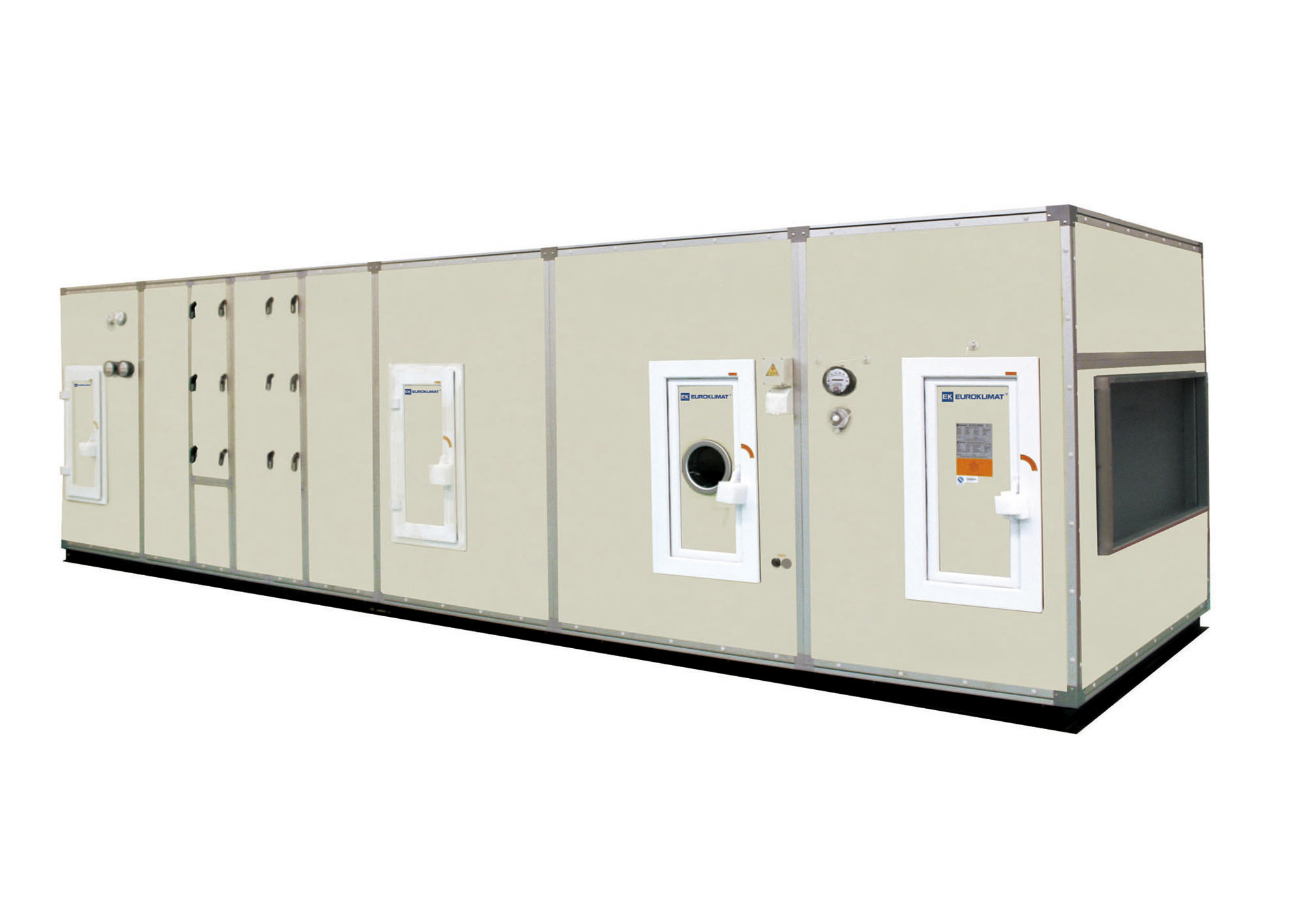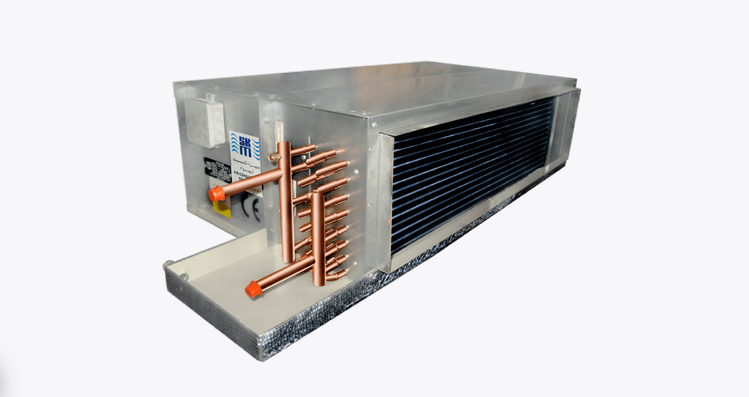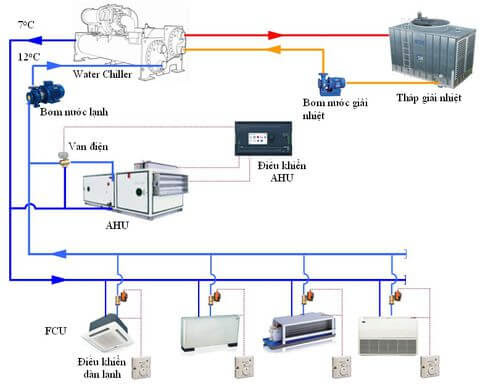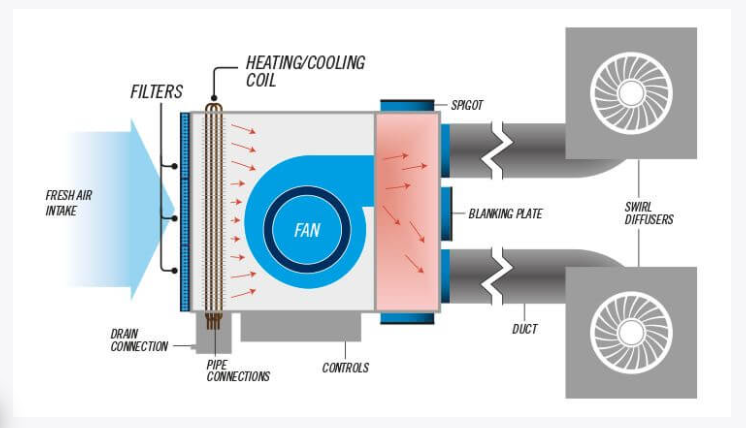Currently, most central air conditioning systems use AHUs. This type of air handling equipment is indispensable for clean rooms. This device plays an important role in air conditioning, heat exchange at a high level. So what is an AHU system? What is FCU? What are the similarities and differences between FCU and AHU air handling equipment? The following article of P69 company will help you answer questions.
What is AHU?
AHU (short for Air Handling Unit) is a heat exchanger and moisture treatment device, creating cleanliness for the air. Commonly connected and used in HVAC systems. The structure of the AHU is much more complicated than that of the FCU and the minimum capacity is 30kW. This technology is applied in almost all manufacturing industries. Places requiring high cleanliness such as pharmaceuticals, foodstuffs, cosmetics, electronics, microelectronics, semiconductors, etc. Currently, AHUs are also installed in many commercial buildings, high-class hotels, homes. workshop,…
Structural features of AHU

Over time, AHUs have become increasingly complex and sophisticated. Depending on the requirements of the project, however, they all have the following general structure:
- Fan.
- Heating unit (Heater).
- Cooler.
- Air filter.
- Protective case.
Application of AHU
AHU equipment is applied in the following fields:
- Manufacturing plants with high requirements for clean rooms: Pharmaceuticals, cosmetics, functional foods, veterinary medicine, food, electronics, medical equipment, pharmaceutical packaging.
- Industrial production plants: Electronic components, high technology, chemicals, petrochemicals, automobiles, fibers, etc.
- Use AHU in systems that require very high standards of cleanliness such as: Hospital operating rooms, laboratory – testing, A&D laboratories.
- In civil: Commercial buildings, large buildings with central air conditioning systems using chillers, large halls, theaters.
What is FCU?
FCU (short for Fan-Coil Unit) is part of the HVAC system. As a device used to treat air, but with a very modest capacity, using insulated flexible ducts in residential buildings, commercial buildings or industrial buildings. FCU is like AHU is an air handling device but has a simple structure and is smaller in size, only about 2kW-20kW.
Structural features of FCU

- Fan (Fan).
- Seamless pipe (Coil).
- Dust filter.
- Engine.
- Seamless heat exchanger tubes.
- Condensation screen.
In some cases, this device also has an additional heater (also known as an electric dryer) but it is not common, especially in Vietnam.
Applications of FCU
- Nowadays, FCU is widely applied in apartment buildings, high-rise buildings, commercial buildings, etc. Particularly for high-rise buildings, it is stacked vertically, straight from floor to floor and connect the FCUs together with the same pipeline.
- In some of these high-rise buildings, the FCU is often mounted in the ceiling of the bathroom or used to provide cold air for areas with not too large space.
Distinguish between AHU and FCU . air handling units
Initially, both types of devices have the same structure and operating principle. However, they have some differences as follows:

1. Demand for use
- FCU: Usually used in common commercial buildings, in small spaces, wind treatment in offices. Most of them are localized areas.
- AHU: This can be considered a large FCU with a mixer and filter attached. This equipment is often used in large, public places and requires high cleanliness requirements such as high-class commercial areas, research workshops, manufacturing electronic components, cosmetics .. They will be installed in a certain room, after the central wind is treated, it will blow into the room.
2. About the size
- FCU is a heat exchanger with a short blowing range, usually less than 20 meters. Besides, the air duct of the FCU is also very short because its fan head is only less than 200Pa.
- AHU is a cooling unit with a large wind range, usually greater than 20 meters. Therefore, its fan pressure head will be large, about 300Pa or more.
3. About the noise level
Because FCU is often used to cool offices, it is very important to pay attention to noise. Also because the head of the FCU fan is small, the noise level is not large. As for AHUs, the opposite is true because they are very noisy. If you want to use this system for the office, you must design more sound absorbers and soundproofing.
4. Heat exchanger
The FCU indoor unit uses refrigerants such as freon HCFC gas, chilled water (chilled) or water mixed with alcohol (glycol). The AHU uses water from the chiller or can also use the same refrigerants as above.
5. About capacity
According to the information presented above, the AHU is a large indoor unit. Therefore, its capacity is also very large and of course larger than the FCU system. The AHU alone can provide enough cold air for a very large room or for many different rooms or for a function room far away from the system installation location.
6. Compare the difference between the operating principle of AHU and FCU
The differences between the operating principle of AHU and FCU include:
6.1. AHU
When the room temperature is higher than the set temperature, the 3-way valve will open for the purpose of allowing cold water to flow through the heat exchanger until the temperature is lower than the set temperature. The fall will close, cold water will flow through the pipe.
The air will be filtered through the pre-filter and bag filter before passing through the AHU, so these components should always be cleaned regularly.
Use a HEPA filter if a high degree of cleanliness is desired. The air from the environment when passing through the filter will contact the AHU’s internal heat exchanger, causing cold air to be generated and the recirculation chamber will blow the cold air through the ducts and then to the use room. use air conditioner.
The fan speed and chilled water valve will control the outlet air temperature. Besides, most of the AHU devices are not accurate because the AHU is mainly responsible for pre-processing the air flow.
6.2. FCU
From the central air conditioner, the inductor will sense hot and cold steam and proceed to remove heat from or add heat to the air through heat transfer.

The round-blown Cassette FCU, available in either 4-way or 1-way models, is designed based on the type of fruit used.
When the inductor senses hot or cold steam from the central air conditioner, it will remove the magnetic heat or add magnetic heat to the air through heat transfer.
Traditional fan coil units will then contain an internal thermostat or may already be wired to work in conjunction with a remote control.
We can also control the speed of the FCU rtong fan motor to heat or cool as desired.
In addition, some FCUs are equipped with a custom permanent self-decoupling motor so that the levels in the coil to set the levels to the desired level simply allow the user to manually adjust the fan speed.
Contact us today for a free consultation and answer at:
Contact information P69 – M&E Contractor
Address: No. 6/165C Xuan Thuy, Cau Giay District, Hanoi
Website: https://p69.com.vn/
Hotline: 02422121212 – 0965937799
Email: kd@cokhip69.com.vn
Facebook: https://www.facebook.com/p69nhathaucodien
LinkedIn: https://www.linkedin.com/in/congtyp69/
Youtube : https://www.youtube.com/channel/UCOUwCnE5iGj8iqe_ZIUM7oA

